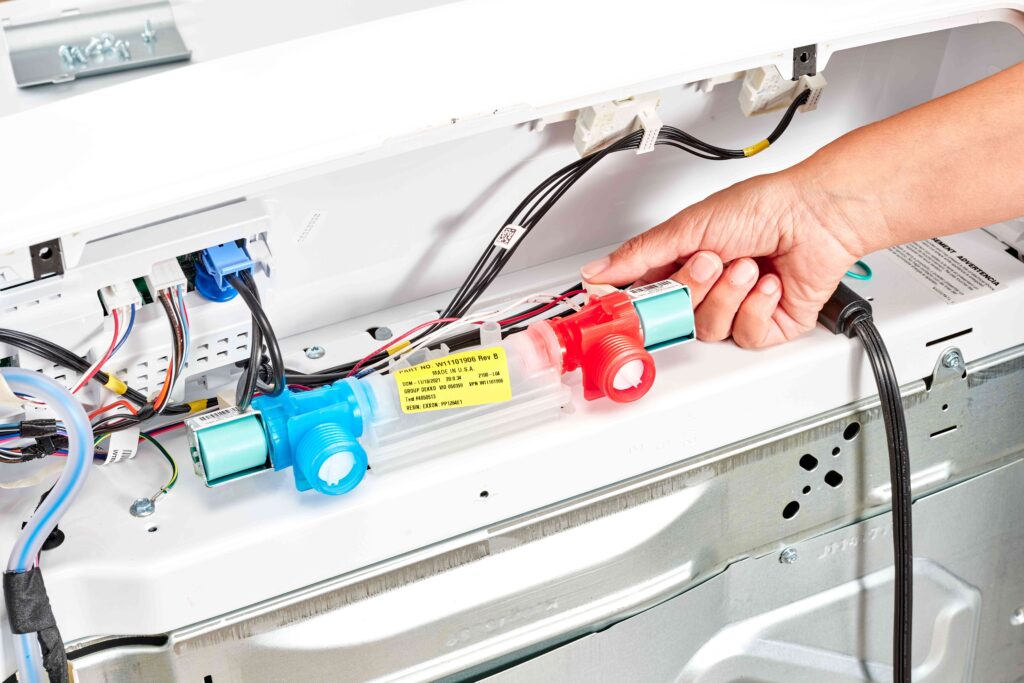How to washing machine water valve on or off? Turning the water supply valve on or off for a washing machine is a simple yet crucial task that helps ensure the machine functions properly and safely. Here’s a comprehensive guide to understanding and executing this task.
Understanding the Water Supply Valves
Washing machines typically have two water supply valves, one for hot water and one for cold. These valves are usually located behind the washing machine and are connected to the house’s water supply.
- Hot Water Valve: This valve controls the flow of hot water into the washing machine. It is usually marked with a red handle or label.
- Cold Water Valve: This valve controls the flow of cold water into the washing machine. It is usually marked with a blue handle or label.

When to Turn the Water Valves On or Off
- During Installation: When installing a new washing machine, the water supply valves must be turned off before connecting the hoses. This prevents water from leaking out and ensures a safe installation process.
- Before Maintenance: Before performing any maintenance or repair work on the washing machine, such as cleaning the filter, inspecting the hoses, or replacing parts, turn off the water supply valves to prevent accidental flooding.
- In Case of Emergencies: If there is a leak or any malfunction in the washing machine, immediately turn off the water supply valves to prevent water damage to your home.
- When Moving the Machine: If you need to move the washing machine for any reason, turn off the water supply valves and disconnect the hoses to avoid spills.
How to Turn the Water Valves On or Off
Tools Needed:
- Adjustable wrench (if needed to loosen tight connections)
- Towels or a bucket (to catch any drips)
Steps:
- Locate the Water Valves:
- The water supply valves are usually located directly behind the washing machine, near the wall. You may need to move the washing machine slightly to access them.
- Turn Off the Water Valves:
- Hot Water Valve: Turn the valve handle clockwise until it stops. This shuts off the hot water supply.
- Cold Water Valve: Turn the valve handle clockwise until it stops. This shuts off the cold water supply.
- Disconnect the Hoses (if necessary):
- Place a towel or bucket underneath the hose connections to catch any drips.
- Use an adjustable wrench if needed to loosen the hose connections.
- Carefully disconnect the hoses from the washing machine and the water supply valves.
- Turn On the Water Valves (when ready to use the machine again):
- Reconnect the hoses to the washing machine and the water supply valves.
- Ensure the connections are tight to prevent leaks.
- Turn the hot water valve handle counterclockwise until it is fully open.
- Turn the cold water valve handle counterclockwise until it is fully open.
- Check for any leaks around the connections.
Troubleshooting Common Issues
- Stuck Valves:
- If the valve handles are difficult to turn, they may be stuck due to mineral buildup or corrosion. Apply a penetrating oil to the valve stems and wait a few minutes. Use a cloth or pliers for extra grip if needed.
- Leaky Valves:
- If water continues to drip from the valves after they are turned off, the valve washers may be worn out. You may need to replace the washers or the entire valve. This might require professional assistance if you are not comfortable with plumbing work.
- No Water Flow:
- If there is no water flow after turning the valves on, check that the hoses are not kinked and that the filters in the hose connections are not clogged. Ensure the valves are fully open.
Tips for Preventive Maintenance
- Regular Inspection: Periodically inspect the water supply valves and hoses for signs of wear or damage. Look for cracks, leaks, or bulging hoses.
- Replace Old Hoses: It is recommended to replace the washing machine hoses every 3-5 years to prevent potential leaks and flooding.
- Use High-Quality Hoses: Consider using braided stainless steel hoses instead of rubber hoses for added durability and resistance to leaks.
- Keep Valves Accessible: Ensure the water supply valves are easily accessible. Avoid placing the washing machine too close to the wall, which can make it difficult to reach the valves in an emergency.
- Install a Water Shut-Off Valve: For added safety, consider installing an automatic water shut-off valve specifically designed for washing machines. These devices can detect leaks and automatically shut off the water supply to prevent flooding.
Conclusion
Knowing how to properly turn the water supply valves on and off for your washing machine is an essential skill that can save you from potential water damage and costly repairs. Whether you are installing a new machine, performing maintenance, or addressing an emergency, following the correct procedures ensures your washing machine operates safely and efficiently. Regular inspection and preventive maintenance can further extend the lifespan of your appliance and help avoid unexpected issues.
Read Also.How to wire a 3 way switch with 4 lights?

